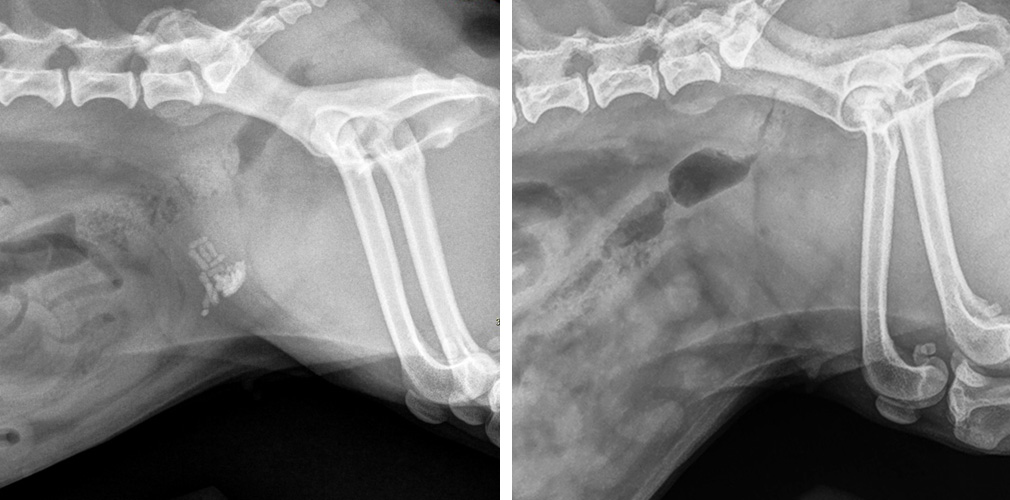Now that a majority of states have legalized medical, and in many cases recreational, marijuana, veterinary emergency rooms are seeing more cases of pets with accidental exposure to marijuana. Tetrahydrocannabinol (THC), the cannabinoid in marijuana that produces psychoactive effects on the brain, is toxic to dogs and cats.

But what about another cannabinoid that does not have mind-altering effects, called cannabidiol, or CBD for short? CBD products claiming therapeutic benefits are marketed not only for people but also for pets. Dr. Gene Pavlovsky, the veterinarian who heads the small animal primary care service at the University of Illinois Dr. John A Coyne South Clinic, shares his clinical experience with CBD for pets.
How CBD Works and What It’s Used For
CBD works by interacting with the body’s endocannabinoid system, a network of neurotransmitters that all mammals have. The endocannabinoid system helps the body balance conditions such as mood, sleep, pain, and inflammation. While THC has direct interaction with cannabinoid receptors on cells, CBD modulates the receptors’ activity in a secondary way. CBD is thought to assist the body in restoring balance after an episode of stress or injury.
Products containing CBD marketed for pets have claimed to treat pain associated with osteoarthritis, itchy skin, epilepsy, anxiety, and aggression. However, there is little published scientific evidence on use and efficacy of CBD.
A 2025 report published by the American Veterinary Medical Association reviewed available studies. Some studies showed that CBD has some efficacy for treatment of osteoarthritis and epileptic seizures in dogs and cats. Currently no studies support the use of CBD in treating behavioral disorders.
“My experience with products containing CBD is limited to discussions of its potential use with clients who are already using it on their pets or are considering doing so,” Dr. Pavlovsky says.
“Because most of my patients who take CBD have complex conditions or take multiple medications or supplements, it is difficult to tell whether any beneficial action is derived from the product. I have not had any experiences with my patients that led me to believe subjectively or objectively that CBD provides a clear benefit.”
Safety Precautions
Dr. Pavlovsky and the AVMA report both warn that CBD products for pets may not adhere to quality control standards. Products may contain compounds not listed on the label. Additionally, they may contain higher or lower quantities of CBD than is indicated.
“There are many variations in naming cannabinoid compounds, which makes knowing what is in a specific product difficult,” notes Dr. Pavlovsky. “It’s often unclear exactly how much CBD is in a commercial product. These products commonly contain other chemical compounds that may affect their safety profile.”
Under current state and federal laws, veterinarians cannot legally dispense or prescribe CBD to a patient. For this reason and because of the lack of evidence of CBD’s efficacy, Dr. Pavlovsky does not recommend that his clients give these products to their pets.
“I have conversations about CBD when clients bring it up,” he says. “I provide them with a quick overview of the evidence behind its use and caution that not all commercial products are the same. Ultimately, I advise them that the lack of regulatory control of such products may result in unpredictable safety, purity, and efficacy.”
Potential Adverse Effects of Cannabinoids
Commercial products containing cannabinoids are generally safe for dogs and cats. Dr. Pavlovsky says that adverse effects do happen, such as poor muscle control in dogs, but are generally not harmful.
The same is not true when it comes to very concentrated marijuana products or illegal synthetic versions. Those products can lead to serious neurologic problems, including tremors, disorientation, seizures, and coma. Other clinical signs of cannabis toxicosis in pets include vomiting, urinary incontinence, hypersalivation, decreased body temperature, and vocalization.
“Pet owners need to be sure their pets cannot access cannabinoids in the home,” Dr. Pavlovsky says. “There is no cure for cannabinoid toxicosis. Veterinary care is limited to supportive care. Examples include giving anticonvulsant or antiseizure drugs, oxygen supplementation, and stabilizing blood pressure and body temperature.”
By Cassidy Kelly




